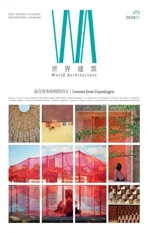3D 打印中的生物可接受性参数
2024-01-27艾瑞尔阿尤布拉齐
艾瑞尔·陈,阿尤布·拉齐
随着城市的发展,人类对地球上有限的空间和资源的争夺不断加剧,许多野生动物因此失去家园甚至失去生命。我们有必要在城市中引入更多植被及其所包含的微生物,以重建一个更多元的生态系统,并通过调节温度和CO2等条件,增强城市环境的可持续性和韧性。生物可接受性设计是将生物多样性融入现有城市基础设施的一种解决方案,尤其适用于高密度城市环境和与自然界隔绝的室内环境。利用3D 打印技术的高精度,我们可以设计出特定的复杂几何形状,起到促进生物生长的作用。
虽然许多设计师已开始涉足生物可接受性结构的设计,但设计参数与生物生长潜力之间的关系仍未被充分探索。因此,本研究试图通过一系列3D 打印的陶瓷构件来研究3D 打印参数与生物生长之间的关系,这些陶瓷构件利用导水几何形状和3D 打印参数来控制生物生长。水分的获取是生物生长的关键因素,因此也是本研究的重点。附生藻类和苔藓是用于研究的目标生物,它们的生长速度相对较快,生长效果明显。本研究在3 个不同的尺度上展开:构件的整体形态、微凹槽的形式和材料孔隙度。我们通过4 项实验测试了陶瓷构件的不同几何参数和制造参数对生物附着能力、水扩散和导流的影响,以及对后续构件上生物的生长速度的影响。
实验结果证明了3D 打印的几何参数和制造参数在影响陶瓷构件的生物可接受性中的重要性。本研究得到的基本参数可作为今后工作中生成生物可接受性几何形式的参考。虽然实验的重点是水分获取和生物附着能力,但包括环境条件在内的许多其他因素也会对生物可接受性产生影响。无论如何,创造生物可接受性结构是将自然重新引入贫瘠的城市环境的重要一步,这需要积极且有意识的设计手法。本研究在几何学、生产制造、生物学等交叉领域的既有知识的基础上,为设计师提供了可供参考的设计参数。随着更多关于生物可接受性设计知识的积淀,我们的设计范式将从创造贫瘠的城市环境转向创造更多与自然有机融合的空间。

4 使用最佳的管道深度和数量可以更好地控制水流 Dye channeling,optimal channel depth and count allow better control of water flow

5 在空腔内插入苔藓,以粘附和促进潮湿的微气候 Insertion of moss within cavities designed to allow adhesion and facilitate moist micro-climates

6 根据实验结果开发原型 Development of prototypes from experiment results
The rise of urban environments corresponds to the displacement and loss of wildlife as humankind competes for limited space and resources.There is a need to introduce vegetation and accompanying microorganisms to recreate a diverse ecosystem and promote more sustainable,resilient urban environments with essential regulation of conditions such as temperature and carbon.Bio-receptive design presents a solution to integrate biodiversity into existing urban infrastructure,particularly in high-density areas or indoor environments isolated from the biosphere.Leveraging on the high level of precision in additive manufacturing,complex and specialised geometry can be designed to promote biological growth.
While many designers have started engaging in creating bio-receptive structures,the relationship between design parameters and growth potential remains an unexplored area.Hence,this research investigates the correlations between parameters in 3D printing and bio-growth through a series of 3D-printed ceramic structures that utilise water-channelling geometries and 3D printing parameters to control biological growth.As a primary factor for growth,water access is the focus of this research;epiphytic algae and bryophytes,which provided relatively fast and visible growth results,are the targeted organisms.The investigation was conducted on three different scales: overall macro form,micro-grooves,and material porosity.The four experiments test the impact of geometrical or fabrication parameters on its ability to allow adhesion of living organisms,water diffusion and channelling,and its subsequent impact on biological growth on the structure.
The results of the experiments highlight the importance of geometrical and fabrication parameters that can affect the resultant bio-receptivity.The basic parameters in this research serve as a guideline for consideration in future work in generating bio-receptive geometries.Although the experiments focus mainly on water access and adhesion of organisms,there are many factors that also play a role in promoting bio-receptivity including the environmental conditions.Nevertheless,the creation of bio-receptive structures is a step towards re-integrating nature into sterile urban environments which requires an active and intentional design approach,and this paper builds upon the existing knowledge for designers in the intersection of geometry,fabrication,and biology.With more build-up of knowledge in producing bio-receptive designs,our design paradigm can shift away from sterile urban environments towards more nature-integrated spaces.
